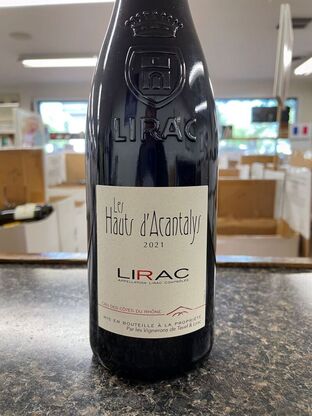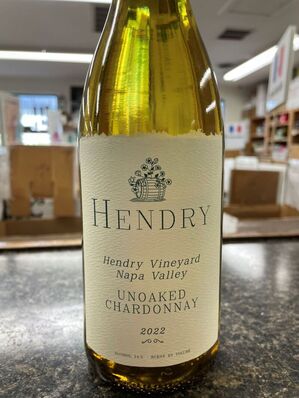INSIDER'S PICK: 2021 LES VIGNERONS DE TAVEL & LIRAC 'LES HAUTS d'ACANTALYS' LIRAC ROUGE $17.998/31/2023  On a map, the Rhone region can look very broad and expansive, with dividing lines drawn arbitrarily. In person it makes sense because of how the geography draws the lines for you, and it actually becomes surprising how quickly some of the major changes happen. Lirac and Tavel sit side by side just across the river from Avignon and Chateauneuf-du-Pape, home to some of the most intense wines in France, yet are combined known more for their Rose production than anything else. The key is in the river itself: the areas to the North and East of it slope up towards the Ardeche Mountains and have a looser rocky soil, while to the South and West the soils are more sand. Though the wine is made by the local co-operative, it is all from a single site just outside of Roquemaure, literally across the bridge from Chateauneuf-du-Pape. A classic Rhone blend of Syrah, Grenache, and Mourvedre, as well as a healthy splash of Carignan from the oldest parcel of vines on the property, this definitely swings with the strength of its neighbors across the way. Lovely kirsch cherry, blackberry, dark spice and iodine on the nose, with nice weight on the palate and a more savory peppery note to the finish than on the nose. Lots of value to be had here.
0 Comments
 The oaky/buttery image of Chardonnay is so ingrained in our collective psyche, it is very easy to forget how tasty the grape can be without all the added bells and whistles. Not everyone can pull it off, it takes not only the right vineyard sites but also the proper clones of the grape. Grape vines can mutate and change subtly over time, and when cuttings are taken from that vine to make new growths they carry those traits, both desirable and undesirable. Over time (decades, even centuries) certain 'clones' become known for distinctive traits such as the size of clusters, weather durability, and distinct flavor quality. Hendry Vineyard, located right on the edge of Napa's Carneros and Mount Veeder appellations, features the famed Dijon clones originating in Burgundy, creating a wine that doesn't need anything added on it to be tasty. Distinctive rich pear and Golden Delicious apple aromas that are a signature of the Dijon clones; barrel aging would give them a caramel/buttery brioche sort of enhancement, but not needed or missed here. The palate is deep and very mouthfilling loaded with crunchy apple fruit and pear skins, naturally dry and zesty with surprising acidity and freshness all the way to the finish. For the oak averse this is about as good as you will find for domestic unoaked Chardonnay, playing on par with similarly priced Burgundies. Immense food possibilities as well, with plenty of body to hold up against richer dishes.  This pair of new arrivals deserve their own double feature today. First of all, the quality is excellent of course, as you would expect from one of the benchmark producers of the Mosel. Secondly, it is inspired by the recent wine exploits of the eldest son of the owners, Pierson, as he has been growing and developing his own passion for the wine world. Followers on our Instagram site will have seen his photos and recollections over the Summer from a German/Austrian mega-tasting he attended, as well as several subsequent winery visits in Germany from his own trip abroad. Meeting Selbach family members at the tasting and then getting to visit them on a more personal level at their home winery is the sort of experience we all aspire to have. It inspires us, and more importantly it cements the importance of family, identity, and a sense of time and place that makes great wine so much more than just a beverage. His notes and pictures are wonderful (more to come); I've known him almost his whole life, and it's sobering to know he is about the same age now as I was when I first took the writing duties for the store. He'll be ghostwriting these emails before we know it without skipping a beat. Anyway, back to the wines. The Incline series are a value built blend of several sites, all of which are vineyards that get featured in their own wines, so the origins are of great quality. They have both this and a Dry labeled bottling; we like this one better, essentially a 'feinherb' or 'halbtrocken' without actually saying so, just enough fruit to knock down the tartness and give some body to the lovely white fruits on the palate. The Pinot Blanc is an excellent deviation from the usual Rieslings in the Mosel, dry and clean with a full fresh palate that contends with our favorite versions of the grape coming from Alsace or the Alto Adige in Italy. Just a great 1-2 punch of wines you may not always gravitate towards as your first choice, we hope they inspire you as much as they did us.  The battle between Chardonnay and Sauvignon Blanc fans is almost as old as wine itself. Well, maybe not THAT old, but it is probably the most frequent source of conflict when customers are gathering wines for get-togethers. It's hard to find the common ground between the roundness and richness of Chardonnay and the grassy, cirtusy side of Sauvignon Blanc, even when you try and blend them together in one wine. So sometimes you need to get creative. Hautes Terres comes from the Limoux region in the Languedoc/Roussillon region of France, most famous for being the origin of making sparkling wine in what be came most known as the 'Champagne method'. Chardonnay is the primary grape used here, as well as a native one called Mauzac, instrumental in making their sparkling wines so distinctive with its musky apple skin notes. Producers are starting to grow more and more fond of working in some still wines like this one as well to the portfolio, especially ones that have more of a 'natural' slant to them. Clean, unoaked fruit on the nose, mostly warm apple with a touch of green citrus skin and refreshing citrus as it opens up. The palate is where it really 'splits the difference' for drinkers, as the weighty mouthfeel of the Chardonnay gets a kick of a grassier note and a hint of the Mauzac musk, just enough to build the extra interest and make it lively. This isn't going to change the minds of a die-hard oak and butter Chardonnay fan or full throated NZ Sauv Blanc drinker, but darn it if there isn't a lot here to make most everyone else happy.  New vintage, new look, and complete rebranding, but same Pansa Blanca wine in the bottle as we've had in the store for previous years. Pansa Blanca, in case you were wondering (and most of you were, like we were when we first came across this wine), is the local name for the Xarel-lo grape in Alella just North of Barcelona. The vast majority of the Penedes region where Cava is made sits South of the city, with Alella separated by the sprawl of the metropolitan area, so much so that the grapes have had time to evolve slight differences in the two areas. Much like the reds from Montalcino in Italy are made with their own identifiable 'clone' of Sangiovese, wineries in Alella feel their Pansa Blanca is different than regular Xarel-lo, and look to feature it as such, especially in still wines like this one. Though the region has lost acreage over recent decades due to urban sprawl up the Northern coastline, the appeal for the wines has grown with the general popularity of lower alcohol wines. A rich golden color in the glass and vibrant lemony first aroma are pure Catalonian sunshine, with lots more citrus and white fruits emerging as it opens up.The palate has a clean, wet quality to the fruit, but still very full and refreshing with a little hit of minerality and skin tannin dryness to the finish. A great lighter seafood accompaniment, in the same vein as coastal Italian or the many fun Greek whites. |
The Best of the Best.We offering free tastings on these wines in the store every Thursday and Friday, and a 10% discount off the retail price through the duration of the day. Come on by and give them a try! Archives
July 2024
Categories |
Location |
|

 RSS Feed
RSS Feed